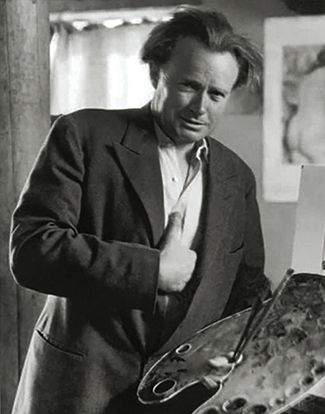
Andrew Dasburg (1887-1979) was born in France and lived in Germany before immigrating to New York City with his family at the age of five. Dasburg showed artistic aptitude from an early age and, as a young man, was awarded a scholarship to the Art Students League in New York.
In 1909 Dasburg returned to Paris to work with fellow artists Morgan Russell, Arthur Lee, and Jo Davidson. He was introduced to the Parisian avant-garde, including Henri Matisse, Pablo Picasso, and author Gertrude Stein. He found resonance with the early development of cubism and the work of Cézanne, which led him to become a pioneer of American modernism. On a short trip to England during this period, Dasburg married sculptor Grace Mott Johnson.
Dasburg and Johnson returned to the United States and became a part of the artist community in Woodstock, New York, frequently returning to New York City for exhibitions. In 1913 Dasburg showed at the First International Exhibition of Modern Art, also known as the Armory Show. Dasburg’s cubist paintings gained immediate attention, and in subsequent years Dasburg was asked to show at Alfred Stieglitz’s renowned gallery ‘291’. During this period, Dasburg also pursued his interest in Synchromism, a movement that emphasized the psychological effects of color and its relationship to music through non-objective cubist abstraction.
Dasburg first went to New Mexico in the early 1900s at the urging of his friends Mabel Dodge and Maurice Sterne, finally settling in Taos in 1933. The striking mountains and valleys of Taos provided the inspiration that was to dominate his work for more than fifty years. The Taos Series, which Dasburg made at Tamarind Institute in 1974-75 at age 87, were his first published lithographs.
Dasburg received several important awards for his work, including the second prize at the Pan American Exhibition, Los Angeles, 1925; third prize at the 26th International of Painting, Carnegie Institute, 1927; and a Guggenheim Fellowship in 1932.
Dasburg’s work is held in numerous museum collections, including the Albuquerque Museum, Barnes Foundation, Dallas Museum of Art, Denver Art Museum, Harwood Museum of Art, Los Angeles County Museum of Art, Metropolitan Museum of Art, Modern Art Museum of Fort Worth, Philadelphia Museum of Art, San Francisco Museum of Modern Art, Santa Barbara Museum of Art, Smithsonian American Art Museum, and the Whitney Museum of American Art.


